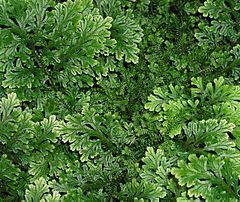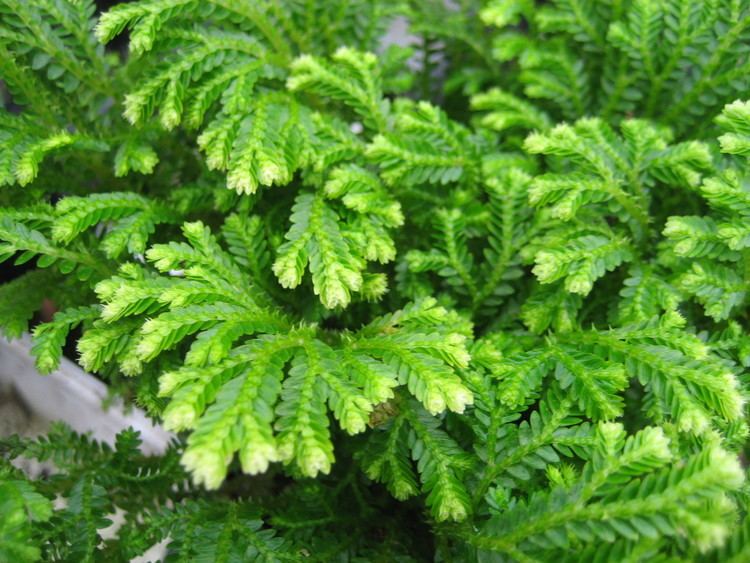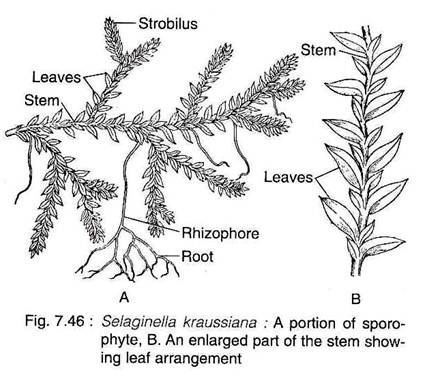Order Selaginellales Scientific name Selaginella Rank Genus | Division Lycopodiophyta Family Selaginellaceae Higher classification Selaginellaceae | |
 | ||
Lower classifications Selaginella lepidophylla, Selaginella kraussiana, Selaginella selaginoides, Selaginella apoda, Selaginella rupestris | ||
Time lapse of growing selaginella plant
Selaginella is the sole genus of vascular plants in the family Selaginellaceae, the spikemosses or lesser clubmosses. This family is distinguished from Lycopodiaceae (the clubmosses) by having scale-leaves bearing a ligule and by having spores of two types. They are sometimes included in an informal paraphyletic group called the "fern allies". S. moellendorffii is an important model organism. Its genome has been sequenced by the United States Department of Energy's Joint Genome Institute. The name Selaginella was erected by Palisot de Beauvois solely for the species Selaginella selaginoides, which turns out (with the closely related Selaginella deflexa) to be a clade that is sister to all other Selaginellas, so any definitive subdivision of the species leaves two taxa in Selaginella, with the hundreds of other species in new or resurrected genera.
Contents
- Time lapse of growing selaginella plant
- Description
- Generic division
- Walton Aston Classification
- Weststrand Korall 2016 Classification
- Zhang Zhou 2015 Classification
- Species
- Cultivation
- References

Description

Selaginella species are creeping or ascendant plants with simple, scale-like leaves (microphylls) on branching stems from which roots also arise. The stems are aerial, horizontally creeping on the substratum (as in Selaginella kraussiana)sub erect (Selaginella trachyphylla)or erect(as in Selaginella erythropus). The vascular steles are polystelic protosteles. stem section shows the presence of more than two protosteles. Each stele is made up of diarch and exarch xylem in centre. The steles are connected with the cortex by means of many tube-like structures called trabeculae, which are modified endodermal cells with casparian strips on their lateral walls. The stems contain no pith.

Unusually for the lycopods, which generally have microphylls with a single unbranched vein, the microphylls of Selaginella species contain a branched vascular trace. In Selaginella, each microphyll and sporophyll has a small scale-like outgrowth called a ligule at the base of the upper surface. The plants are heterosporous with spores of two different size classes, known as megaspores and microspores.
Under dry conditions, some species of Selaginella can survive dehydration. In this state, they may roll up into brown balls and be uprooted, but can rehydrate under moist conditions, become green again and resume growth. This phenomenon is known as poikilohydry), and poikilohydric plants such as Selaginella bryopteris are sometimes referred to as resurrection plants.
Generic division
Many scientists still place the Selaginellales in the class Lycopodiopsida (often misconstructed as "Lycopsida"). Some modern authors recognize three generic divisions of Selaginella: Selaginella, Bryodesma Sojak 1992, and Lycopodioides Boehm 1760. Lycopodioides would include the North American species S. apoda and S. eclipes, while Bryodesma would include S. rupestris (as Bryodesma rupestre). Stachygynandrum is also sometimes used to include the bulk of species.
The first major attempt to define and subdivide the group was by Palisot de Beauvois in 1803-1805. He established the genus Selaginella as a monotypic genus, and placed the bulk of species in Stachygynandrum. Gymnogynum was another monotypic genus, but that name is superseded by his own earlier name of Didiclis. This turns out, today, to be a group of around 45-50 species also known as the Articulatae, since his Didiclis/Gymnogynum genus was based on Selaginella plumosa. He also described the genus Diplostachyum to include a group of species similar to Selaginella apoda. Spring inflated the genus Selaginella to hold all selaginelloid species four decades later.
Phylogenetic studies by Korall & Kenrick determined that the Euselaginella group, comprising solely the type species, Selaginella selaginoides and a closely related Hawaiian species, Selaginella deflexa, is a basal and anciently diverging sister to all other Selaginella species. Beyond this, their study split the remainder of species into two broad groups, one including the Bryodesma species, the Articulatae, section Ericetorum Jermy and others, and the other centered on the broad Stachygynandrum group.
Walton & Aston Classification
In the Manual of Pteridology, the following classification was used by Walton & Alston:
genus: Selaginella
However, this is now known to be highly paraphyletic in most of its groupings. Two recent classifications, employing modern methods of phylogenetic analysis, are as follow:
Weststrand & Korall, 2016 Classification
genus: Selaginella
Zhang & Zhou, 2015 Classification
genus: Selaginella
Species
There are about 750 known species of Selaginella, showing a wide range of characters; the genus is overdue for a revision which might include subdivision into several genera. Better-known spikemosses include:
A few species of Selaginella are desert plants known as "resurrection plants", because they curl up in a tight, brown or reddish ball during dry times, and uncurl and turn green in the presence of moisture. Other species are tropical forest plants that appear at first glance to be ferns.
Cultivation
A number of Selaginella species are popular plants for cultivation, mostly tropical species. Some of the species popularly cultivated and actively available commercially include:
